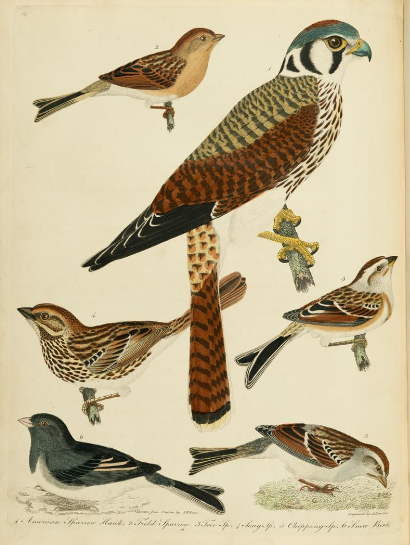
It’s one of the great commonplaces in the age-old Wilson vs. Audubon debate: Wilson’s birds are more “accurate,” but the aesthetic value of his plates is sadly diminished by the pell-mell crowding of so many species onto a single leaf.
Neither of those statements is invariably true, and the second one — the assertion of Wilson’s inability to compose a pleasing plate for the American Ornithology — is unfair. Wilson and his engraver and publisher were subject to different economic constraints from those in which Audubon worked more than a decade later. And unlike the late plates in Audubon’s Birds of America, some of Wilson’s bustling pages were put together with an idea behind them.
How do we know? Because Wilson says so.
Take Plate 16, which seems to throw together five not especially closely related passerellid sparrows and a joltingly dominant female American kestrel. It all seems uncomfortably miscellaneous until we read Wilson’s words on the composition: wintertime juncos, he writes,
have also recourse, at this severe season, when the face of the earth is shut up from them, to the seeds of many kinds of weeds that still rise above the snow, in corners of fields, and low sheltered situations along the borders of creeks and fences, where they associate with several species of Sparrows, particularly those represented on the same plate…. In the vicinity of places where they were most numerous I observed the small Hawk, represented in the same plate, and several others of his tribe, watching their opportunity, or hovering cautiously around, making an occasional sweep among them, and retiring to the bare branches of an old cypress to feed on their victim.
The assemblage, in other words, is an ecological one, and the birds on the plate were brought together to illustrate not just their identifying characters but their relationships one to the other on the bitter cold farmfields and roadsides of winter.
Had Audubon thought to paint those same relationships, I don’t doubt that the scene would have been far more dramatic and far more colorful, with blood and feathers flying. Myself, I have to say that I prefer Wilson’s subtlety, his restraint, and his powerful ability to articulate words and images in the American Ornithology.
You?

